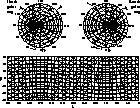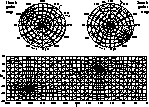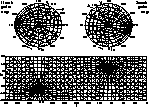Object coordinates are usually given in the equatorial ![]() ,
,
![]() sytem.
sytem.
The zodiacal light is given in terms of ecliptic coordinates
![]() with the zero point of
with the zero point of
![]() in the Sun.
Description of a line of sight by elongation
in the Sun.
Description of a line of sight by elongation ![]() and inclination
i also is common. For the relation between these two sets
of coordinates see Fig. 2 (click here)
and Sect. 3.5 (click here) below.
and inclination
i also is common. For the relation between these two sets
of coordinates see Fig. 2 (click here)
and Sect. 3.5 (click here) below.
Integrated starlight is naturally presented in galactic coordinates
l,b.
For estimates of the diffuse background brightness at a given position, transformation between these three systems is necessary. Figures 3 (click here)-7 (click here) provide a simple way to do so graphically with about one-degree accuracy, which is sufficient for many applications. The underlying transformation equations are summarised below for ease of access.
Airglow, extinction and scattering are best described in the local horizontal system A, z (azimuth, zenith distance). The transformation to the other systems depends on time and on the observer's geographic coordinates. For the horizontal system, only the equations for the transformation to the equatorial system are given.
The obliquity of the ecliptic is essentially constant,
![]() = 23.446
= 23.446![]() for equinox 1950, respectively
for equinox 1950, respectively
![]() = 23.439
= 23.439![]() for equinox 2000.
for equinox 2000.
The precession of the vernal equinox along the ecliptic
is p0 = 50.3 ''/year. Hence
![]()
The north ecliptic pole is
at ![]() = 18 h,
= 18 h, ![]() .
.
The north celestial pole is
at ![]() ,
, ![]() .
.
Both ![]() and
and ![]() are counted eastward
from the vernal equinox.
Apart from the minimal change in
are counted eastward
from the vernal equinox.
Apart from the minimal change in ![]() , the transformation
equations then are the same for 1950 and 2000:
, the transformation
equations then are the same for 1950 and 2000:
By IAU decision, for equinox 1950 the north galactic pole (NGP)
is at ![]() =
12 h 49.0 m,
=
12 h 49.0 m, ![]() = 27.4
= 27.4![]() and
the celestial pole at l = 123.0
and
the celestial pole at l = 123.0![]() , b =
27
, b =
27![]() 24.0'. Hence
the ascending node of the galactic equator is at
24.0'. Hence
the ascending node of the galactic equator is at
![]() = 18 h 49.0 m = 282.25
= 18 h 49.0 m = 282.25![]() ,
, ![]() = 33.0
= 33.0![]() .
For equinox 2000, the coordinates of the north galactic pole are
.
For equinox 2000, the coordinates of the north galactic pole are
![]() = 12 h 51.42 m,
= 12 h 51.42 m, ![]() = 27
= 27![]() 07.8', and
we have
07.8', and
we have ![]() = 282.86
= 282.86![]() ,
, ![]() = 32.93
= 32.93![]() .
The inclination of the galactic equator with respect to the ecliptic
is
.
The inclination of the galactic equator with respect to the ecliptic
is ![]() . As
. As ![]() and
and ![]() ,
l is also counted eastwards.
,
l is also counted eastwards.
With these parameters, the transformations are as follows:
In ecliptic coordinates, for equinox 1950 the north galactic pole is at
![]() = 179.32
= 179.32![]() ,
, ![]() = 29.81
= 29.81![]() , and the ascending node
of the galactic equator at
, and the ascending node
of the galactic equator at ![]() = 269.32
= 269.32![]() ,
l1 = 6.38
,
l1 = 6.38![]() . For equinox 2000, the coordinates of the north
galactic pole are
. For equinox 2000, the coordinates of the north
galactic pole are ![]() = 180.02
= 180.02![]() ,
, ![]() = 29.81
= 29.81![]() ,
and we have
,
and we have ![]() = 270.02
= 270.02![]() , l1 = 6.38
, l1 = 6.38![]() .
The inclination of the galactic equator with respect to the ecliptic
is
.
The inclination of the galactic equator with respect to the ecliptic
is ![]() . As already mentioned, l is
counted eastwards.
With these parameters, the transformations are as follows:
. As already mentioned, l is
counted eastwards.
With these parameters, the transformations are as follows:
The transformation depends on local sidereal time ![]() and on geographical latitude
and on geographical latitude ![]() . Instead of elevation,
zenith distance z = will be used.
The zenith distance of the celestial pole is
. Instead of elevation,
zenith distance z = will be used.
The zenith distance of the celestial pole is ![]() .
Both, azimuth A and hour angle
.
Both, azimuth A and hour angle ![]() are
counted from the meridian through west.
are
counted from the meridian through west.
Instead of ![]() also
a sun-centered polar coordinate system is used. Its coordinates are the angular
distance from the sun, called elongation
also
a sun-centered polar coordinate system is used. Its coordinates are the angular
distance from the sun, called elongation ![]() , and a position
angle i, counted from the ecliptic counterclockwise,called inclination.
The relation between the two sets of coordinates,
when describing the position of a field-of-view with respect to the sun,
is shown in Fig. 2 (click here).
, and a position
angle i, counted from the ecliptic counterclockwise,called inclination.
The relation between the two sets of coordinates,
when describing the position of a field-of-view with respect to the sun,
is shown in Fig. 2 (click here).
It is unfortunate that the obliquity of the ecliptic, used in Eqs.
(3 (click here)) and (4 (click here)),
and the angular distance from the sun, used
in Eqs. (11 (click here)) and (12 (click here)),
both are designated by the same letter ![]() .
However we did not want to change the commonly used notations. In
practice this dual meaning rarely should lead to confusion.
.
However we did not want to change the commonly used notations. In
practice this dual meaning rarely should lead to confusion.
![]()
Figure 2: Relation between the coordinates used for presenting zodiacal
light measurements. ![]() is counted positive towards east,
i is counted positive counterclockwise from the ecliptic
west of the Sun
is counted positive towards east,
i is counted positive counterclockwise from the ecliptic
west of the Sun
The reader is cautioned that in some papers the differential helioecliptic
longitude ![]() may be called "elongation" or may
be designated as "
may be called "elongation" or may
be designated as "![]() ", contrary
to our definition of elongation
", contrary
to our definition of elongation ![]() as the angular distance from
the sun to the field-of-view.
as the angular distance from
the sun to the field-of-view.

Figure 3: Relation between coordinates ![]() (lines)
and
(lines)
and ![]() (underlying dotted grid) for equinox 2000
(underlying dotted grid) for equinox 2000

Figure 4: Relation between coordinates ![]() (lines)
and l, b (underlying dotted grid) for equinox 2000
(lines)
and l, b (underlying dotted grid) for equinox 2000

Figure 5: Relation between coordinates l, b (lines)
and ![]() (underlying dotted grid) for equinox 2000 -
alternative projection
(underlying dotted grid) for equinox 2000 -
alternative projection

Figure 6: Relation between coordinates ![]() (lines)
and l, b (underlying dotted grid) for equinox 2000
(lines)
and l, b (underlying dotted grid) for equinox 2000

Figure 7: Relation between coordinates l, b (lines)
and ![]() (underlying dotted grid) for equinox 2000 -
alternative projection
(underlying dotted grid) for equinox 2000 -
alternative projection
| Site | IB(max) | IB(min) | IV(max) | IV(min) | Solar flux | Corresponding dates | ref. |
| ESO | 22.74 | 21.69 | 164 | 78-02-05 | 1. | ||
| (22.20) | (20.85) | 168 | 80-12-06; 80-06-08; 88-12-05 | ||||
| 22.97 | 161 | 78-02-08 | |||||
| (22.94) | 116 | 78-02-08; 87-12-16; 87-12-19; | |||||
| 21.91 | 162 | 78-02-07 | |||||
| (22.02) | 94 | 87-12-15; 87-12-16; 87-12-19; | |||||
| Calar Alto | 22.51(22.30) | 61 | 95-05-26,27,28 | 2. | |||
| 23.05(22.98) | 176 | 89-05-06; 90-06-26; 93-06-21 | |||||
| (21.16) | 206 | 89-05-04; 91-06-11; 91-06-16 | |||||
| 21.79 | 61 | 95-05-27,28,29 | |||||
| San Benito Mt. | 22.37 | 21.32 | 233 | 80-04-11; 81-07-28; 82-06-22 | 3. | ||
| 23.08 | 78 | 76-04-30; 87-04-25; 87-06-29 | |||||
| 22.07 | 76 | 76-04-30; 87-04-28; 87-06-29 | |||||
| Kitt Peak | 22.65 | 114 | 88-01-21; 88-03-17; 88-06-14 | 4. | |||
| 22.98 | 75 | 86-12-02; 86-12-30; 87-06-22 | |||||
| 21.60 | 114 | 87-11-20; 88-03-17; 88-06-14 | |||||
| 22.01 | 75 | 86-12-02; 86-12-31; 87-06-22 | |||||
| Crimea | 21.91 | 21.10 | 122 | 68-04-28; 71-04-25; 70-08-09 | 5. | ||
| 23.05 | 22.05 | 136 | 68-03-29; 68-04-06; 68-04-28 | ||||
| Hawaii | 22.27 | 210 | 88-11-13; 89-03-28; 89-09-12 | 6. | |||
| 23.03 | 142 | 87-08-26; 87-11-13; 89-06-10 | |||||
| 21.21 | 166 | 85-12-13; 88-11-13; 89-03-28 | |||||
| 22.05 | 102 | 86-06-02; 87-08-26; 88-07-18 | |||||
| McDonald | 22.54 | 21.54 | 138 | 60-02-04; 72-12-30; 73-01-12 | 7. | ||
| Observatory | 23.01 | 156 | 60-01-27; 72-01-11; 72-01-15 | ||||
| 21.92 | 159 | 60-01-27; 72-01-15; 73-01-08 | |||||
| 1. Mattila et al. (1996a). | |||||||
| 2. Leinert et al. (1995), Leinert et al. (1996, unpublished). | |||||||
| 3. Walker (1988). | |||||||
| 4. Pilachowski et al. (1989). | |||||||
| 5. Lyutyi & Sharov (1982). | |||||||
| 6. Krisciunas (1990). | |||||||
| 7. Kalinowski et al. (1975). | |||||||